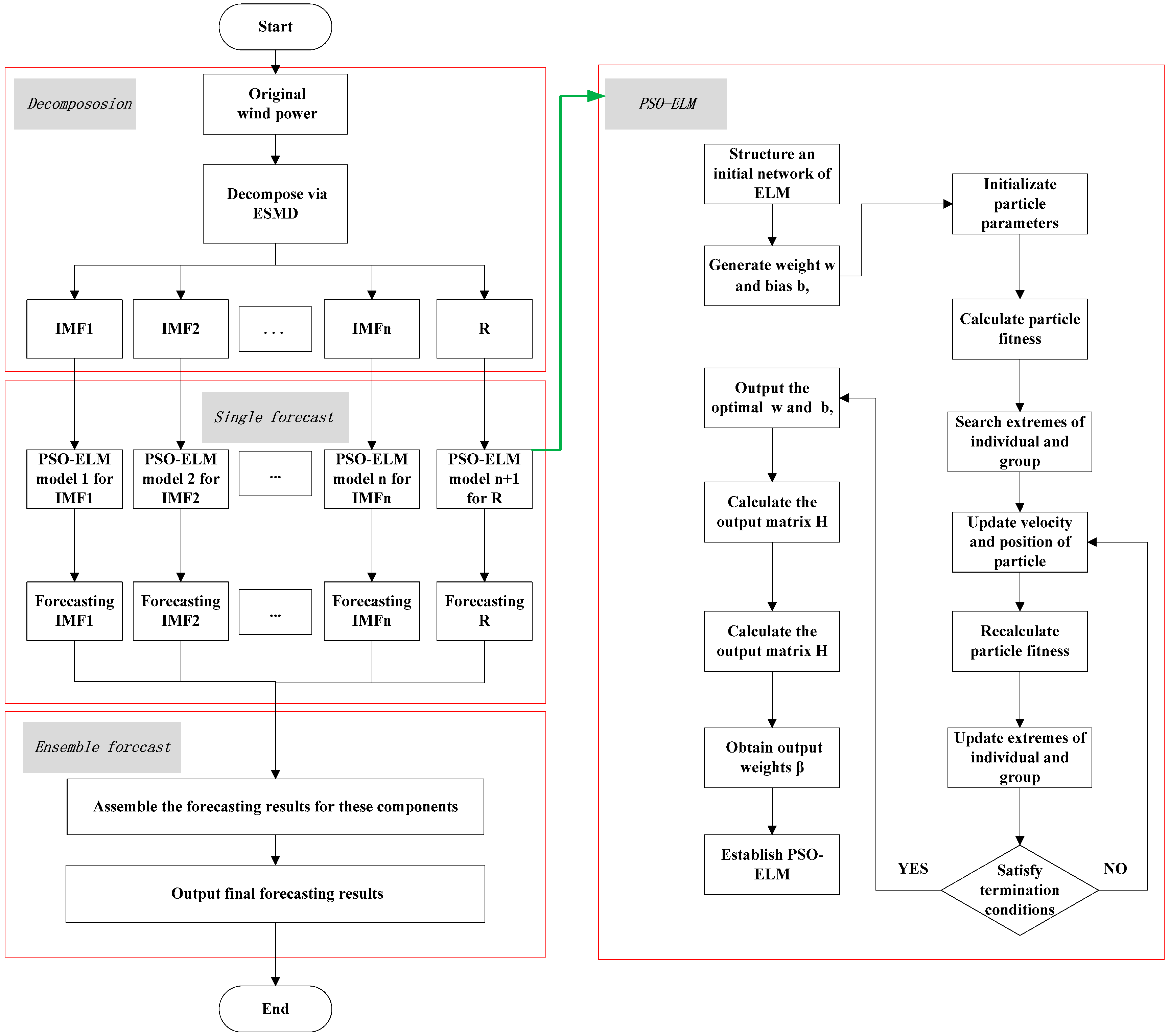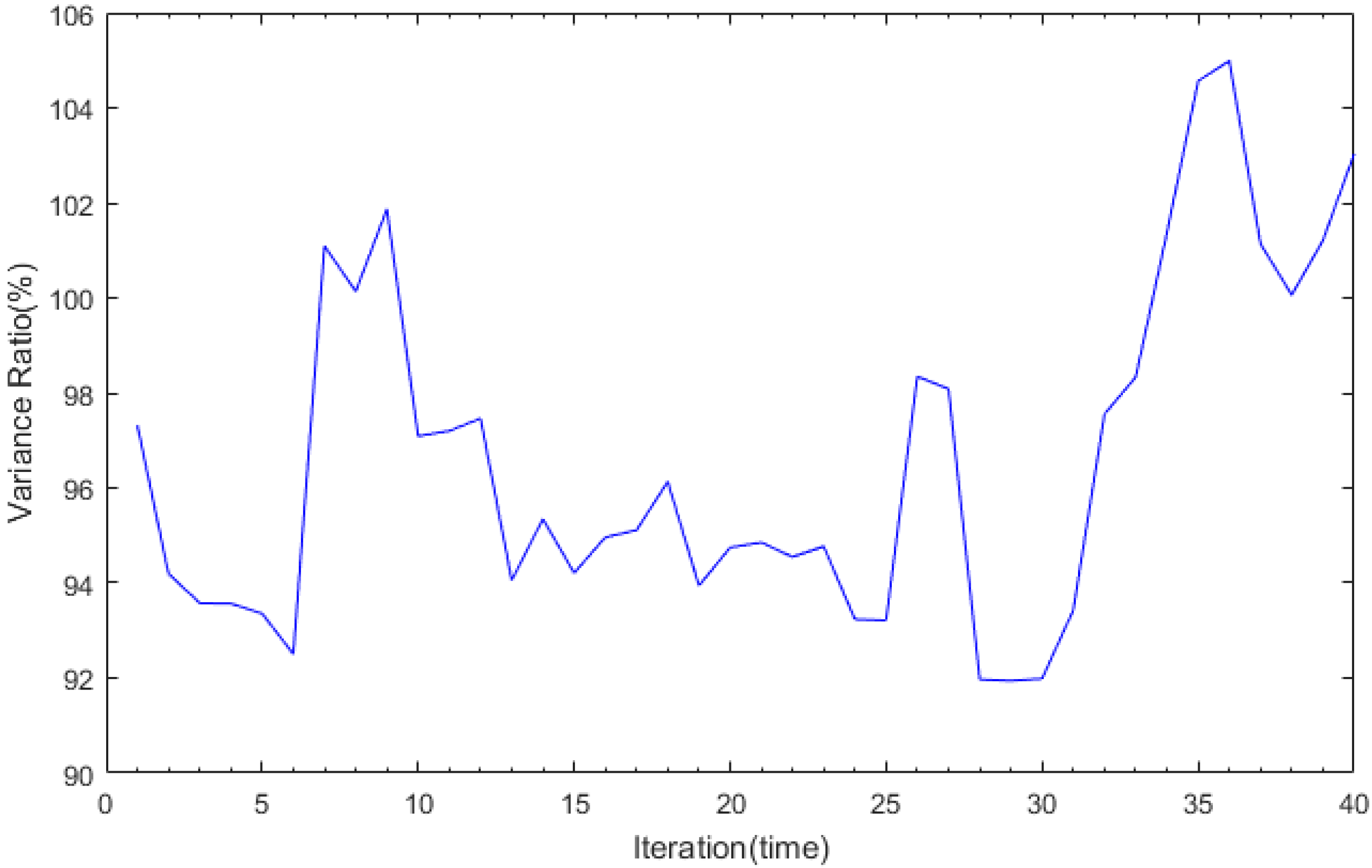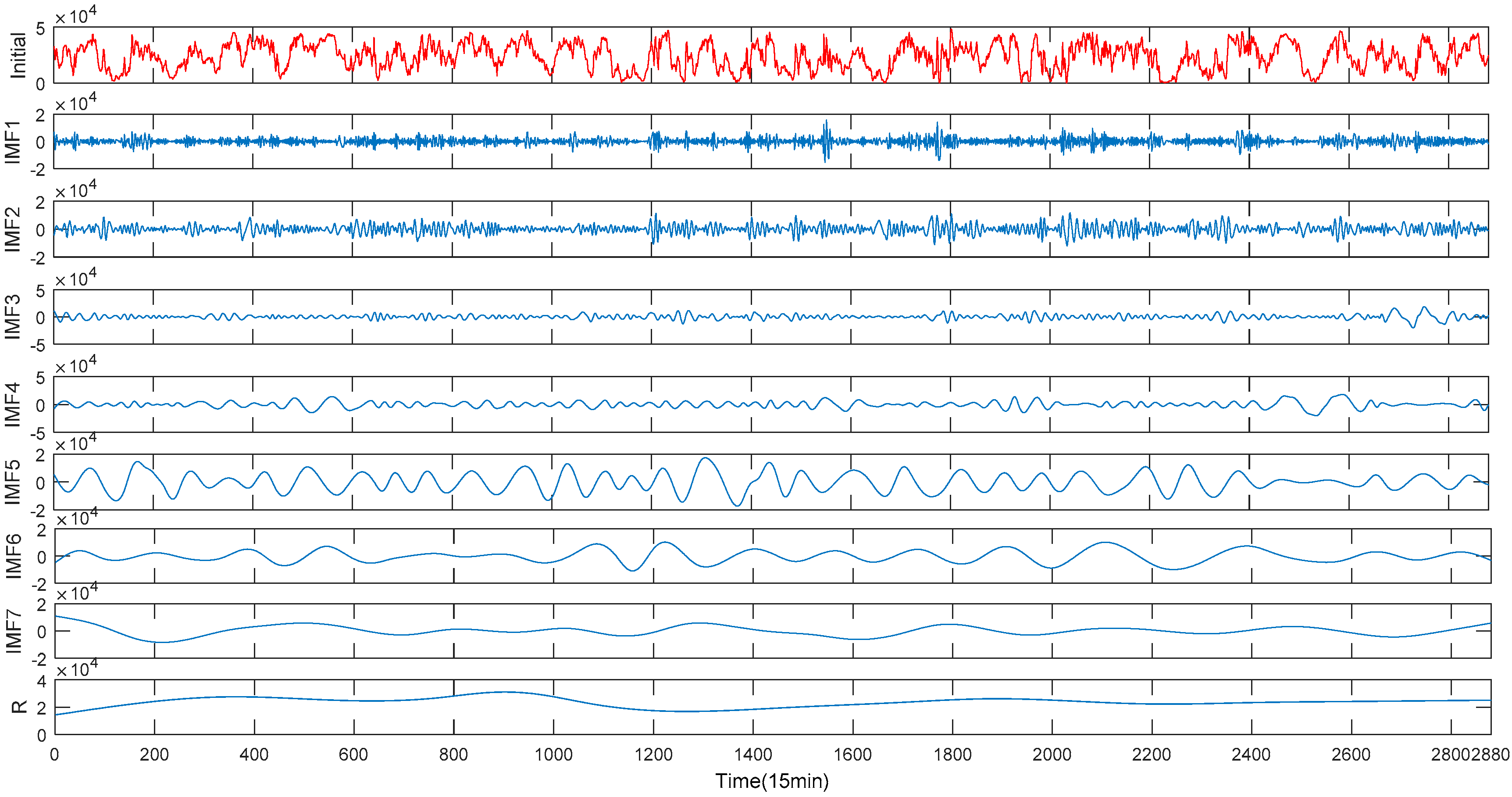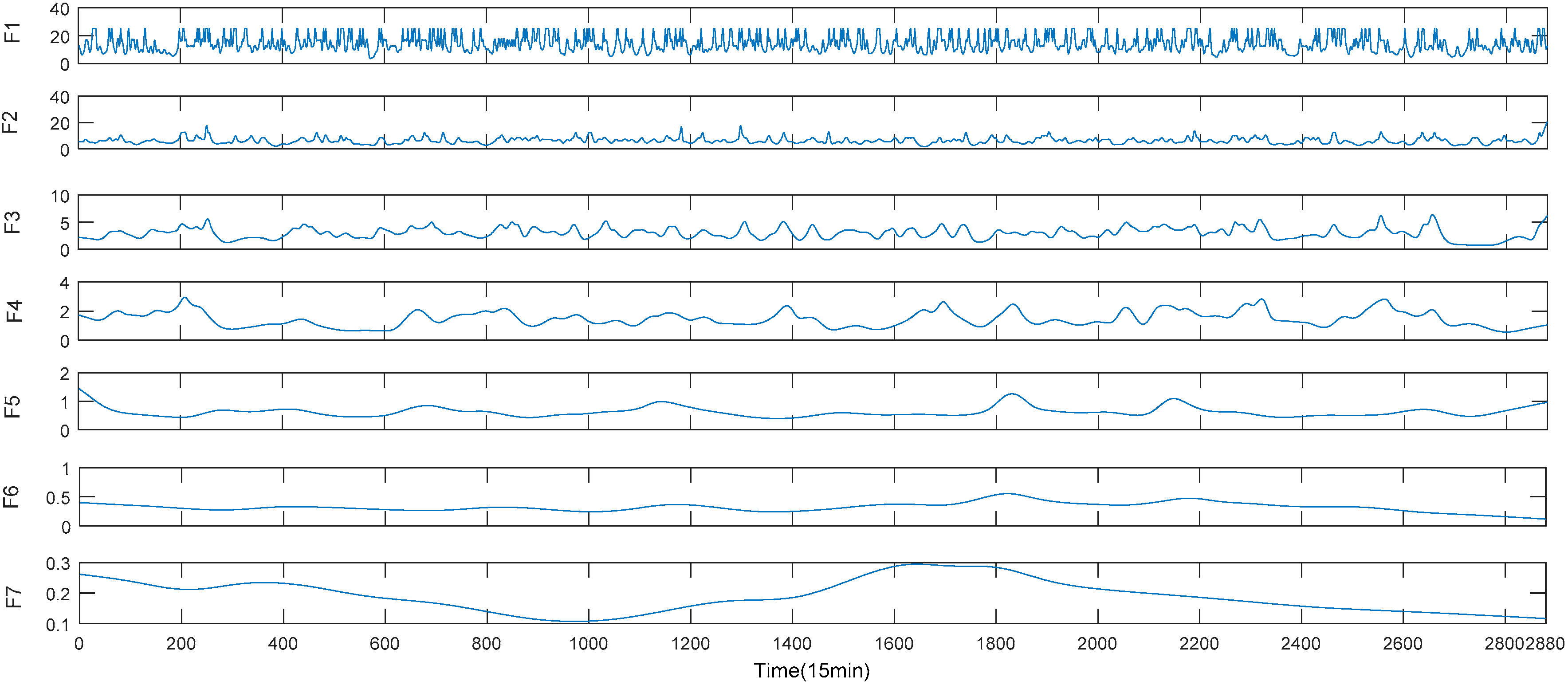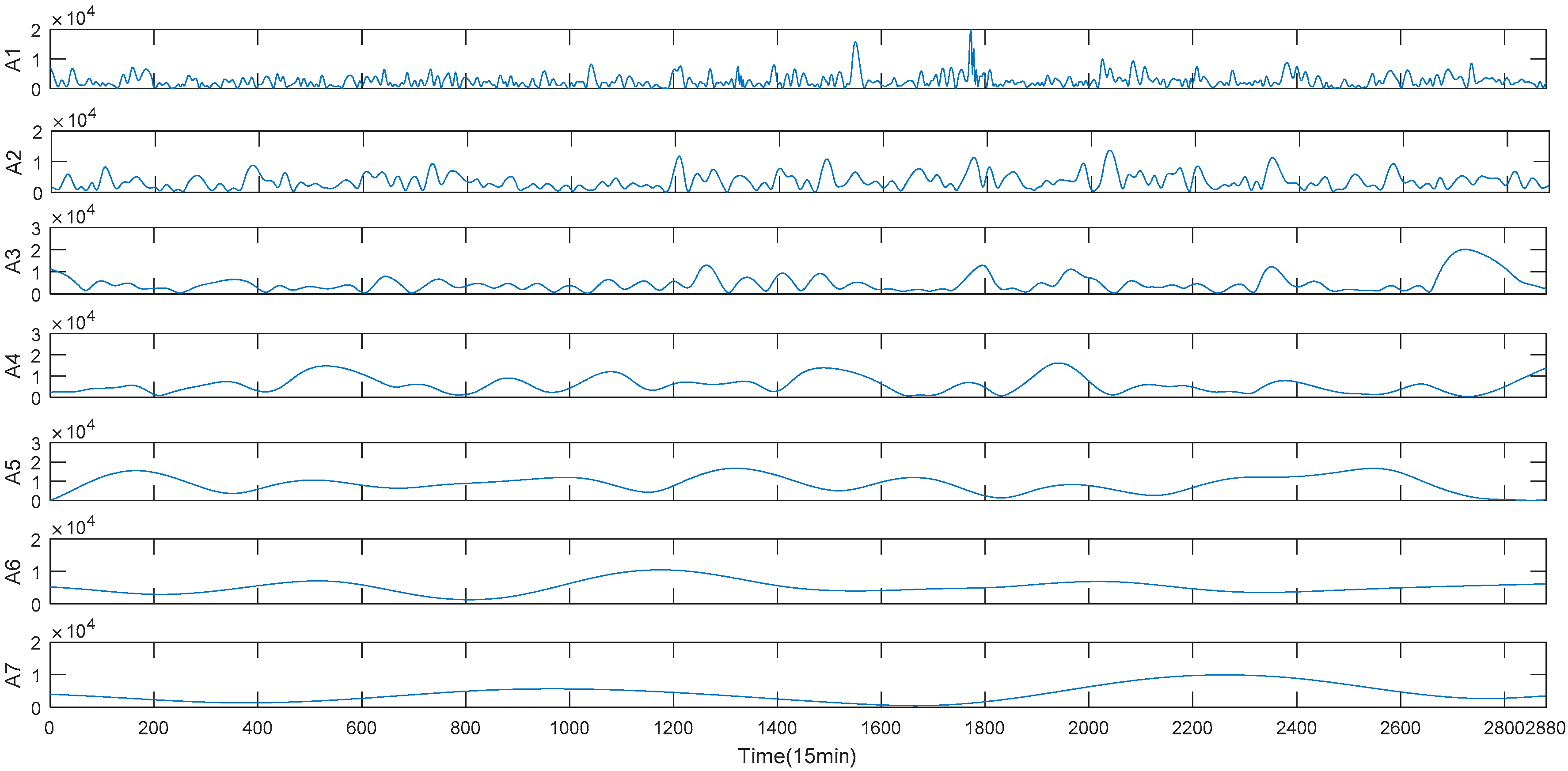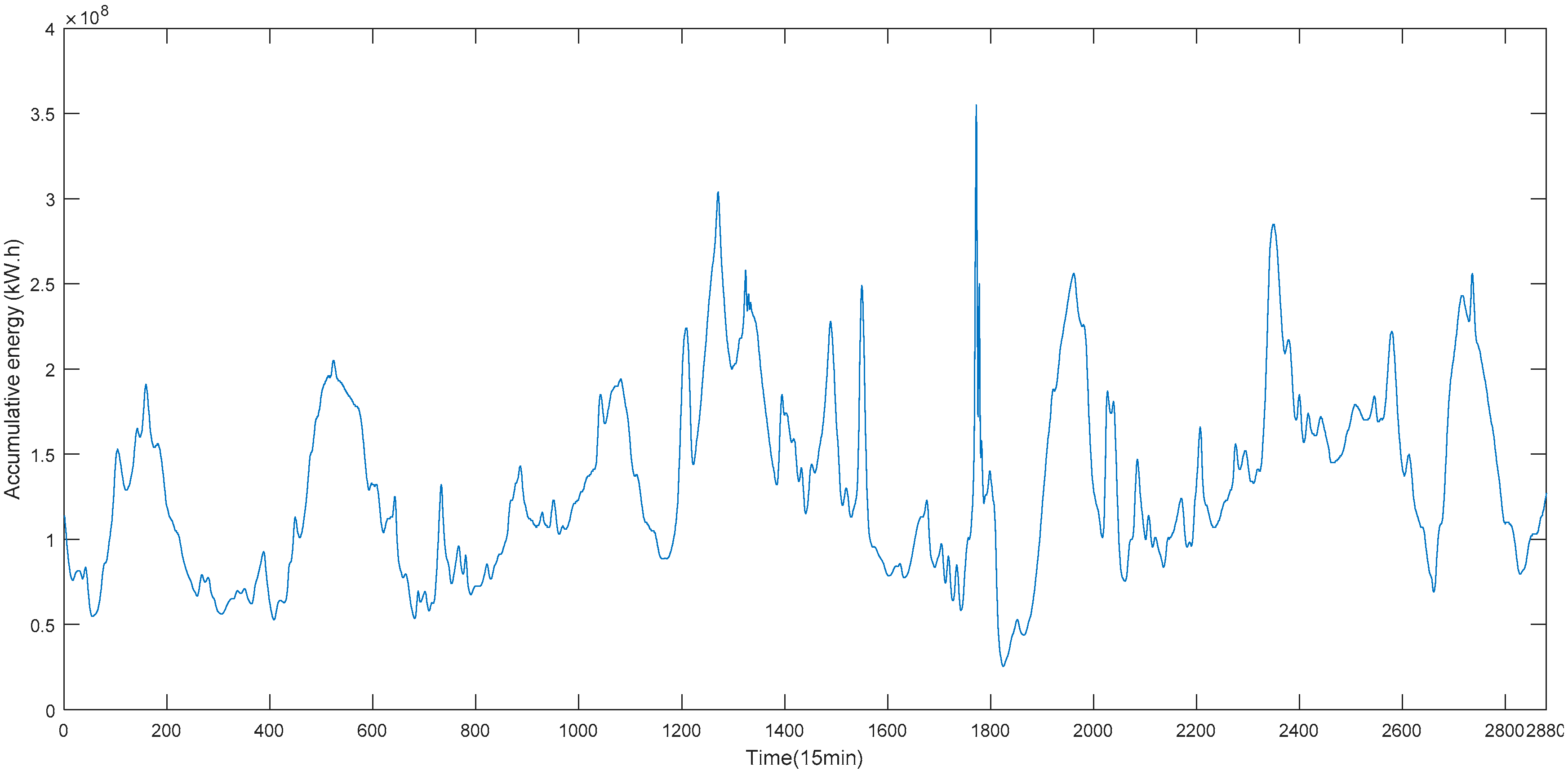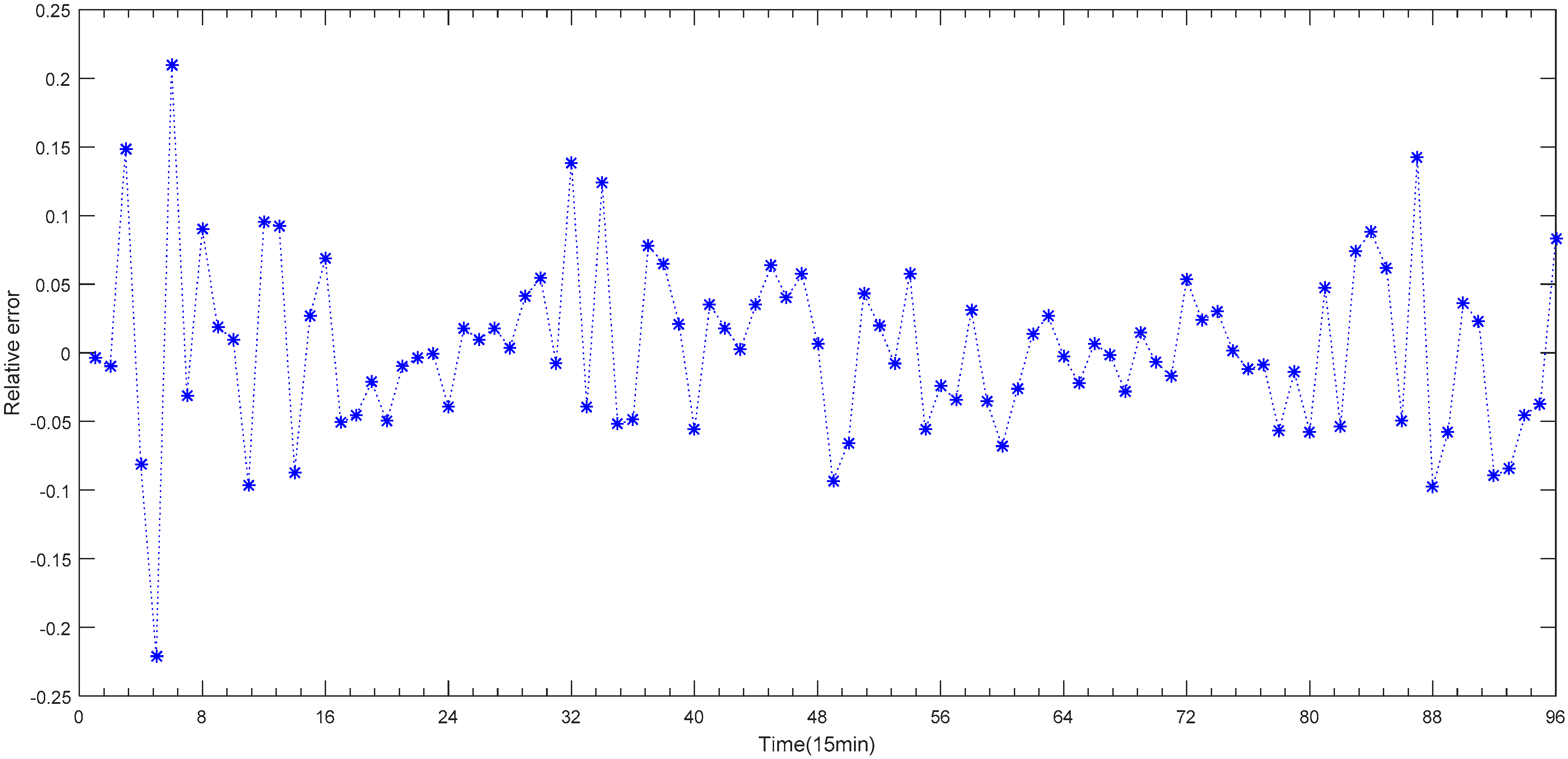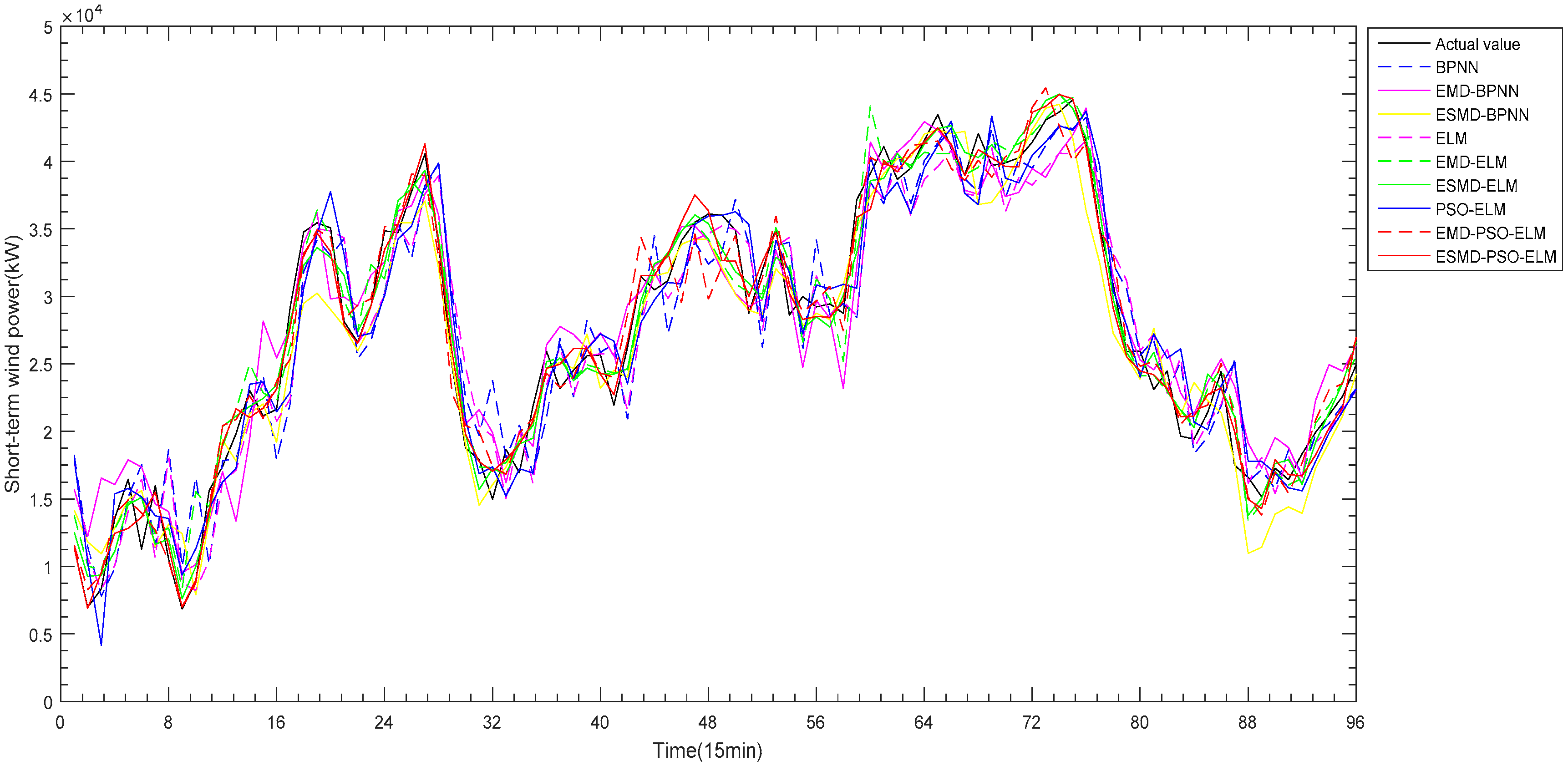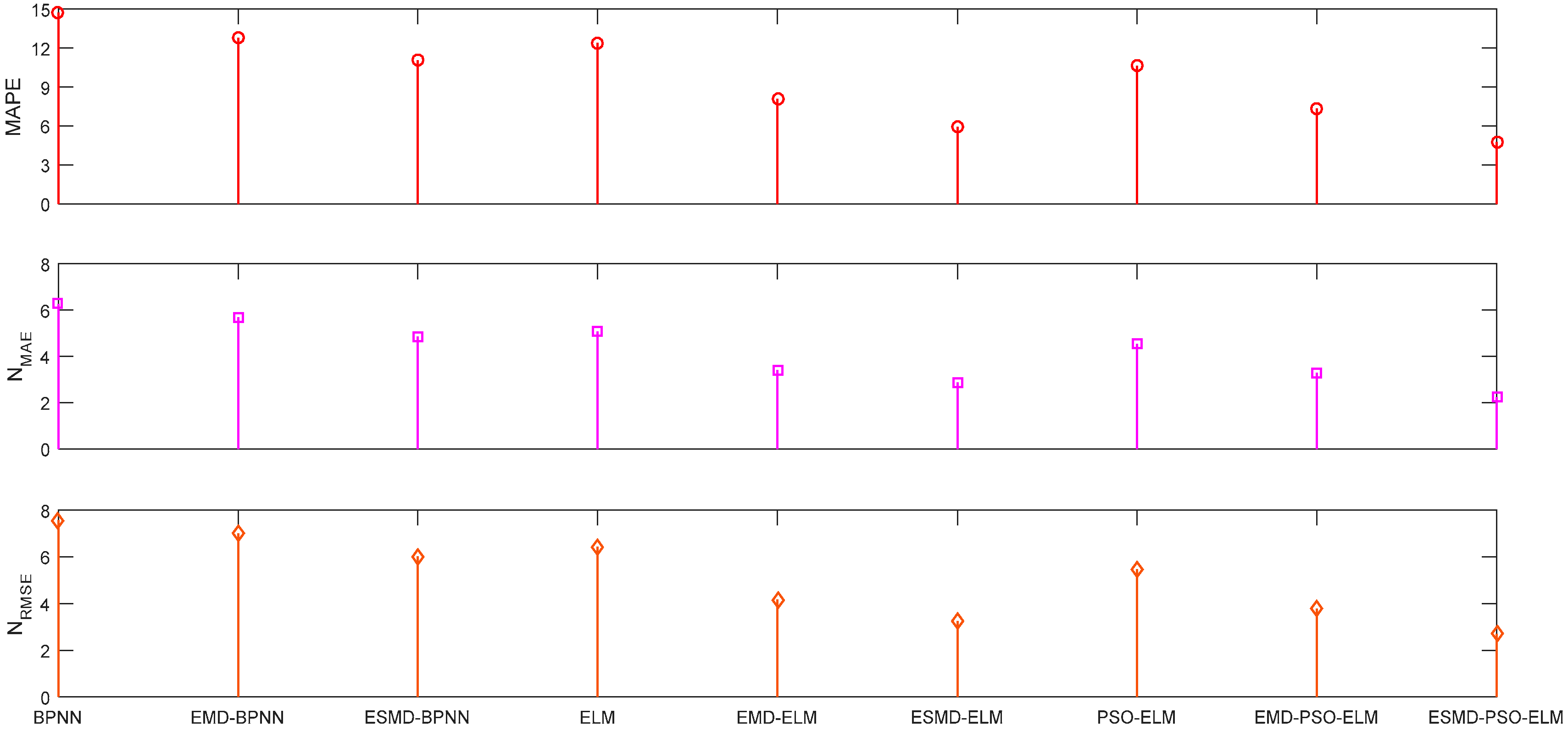1. Introduction
The utilization of renewable energy is one of the world’s hot topics. As an essential component of renewable energy, wind energy is an environmentally friendly clean energy and its development has been highly valued by all countries including China. In recent years, under the guidance and motivation of renewable energy law, the policy of energy-saving and emission-reduction in China, new energy power generation is burgeoning, especially wind power, and the account for the proportion of low valley load capacity has increased. However, it can seriously affect the quality of the grid power and the operation of the power system when the proportions of wind power in the network load more than a certain value. Simultaneously, the characteristics of instability and volatility also have an unbearable impact on the power system. The most effective way to conquer the shortcomings is to forecast wind power, so that the electric power dispatching departments can ensure the safety of the power balance of the power grid according to the change in wind power.
As for wind power prediction, there are different partitions on the basis of different scales. The prediction time scale can be divided into long-term forecast, medium-term forecast and short-term prediction. Meanwhile, according to the prediction of physical quantities, it can be roughly divided into two categories: a direct method and an indirect method [
1]. The first category, which can be called the statistical model, is to forecast the wind power directly; this method has a strong dependency on the input data and is based on the assumption that linear structures exist among time series. Faghani et al. exploited the extrapolation methods to robustly determine wind speed and wind power density at higher altitudes, which can be extrapolated to the wind speeds data at any heights within any geographical region [
2]. In order to overcome the limitations of the individual forecasting models, Song et al. built a combined model with the theory of a data preprocessing technique, forecasting algorithms, advanced optimization algorithm, and no negative constraint [
3]. Han et al. investigated historical wind power data and used Phase Space Reconstruction (PSR), Principle Component Analysis (PCA) and Resource Allocating Network (RAN), respectively, to analysis the wind power [
4]. With the aim of demonstrating the effect of the proven model, the study made a comparison with Persistence (PER), New-Reference (NR), and Adaptive Wavelet Neural Network (AWNN) models.
Jiang and Huang improved the real–time decomposition-based forecasting method; at the same time, they used feature selection and error correction to enhance the performance of the model and the prediction accuracy [
5]. Oktay et al. believed that the wind speed time series has non-linear characteristics, then, the study adapted Polynomial AR (PAR) models to make power predictions, and compared the differences between PAR and artificial neural network adaptive neuron fuzzy inference system (ANN-ANFIS) models [
6]. Ilhami et al. developed the moving average (MA), weighted moving average (WMA), autoregressive moving average (ARMA) and autoregressive integrated moving average (ARIMA) methods to forecast wind speed and wind power at different time horizons [
7]. Zhao et al. proposed a self-adaptive (SA) and an auto-regressive integrated moving average (ARIMAX) optimized by a chaotic particle swarm optimization (CPSO) algorithm, which can be called the SA-ARIMA-CPSO approach, to predict wind speed. It concluded that the hybrid model has the best performance compared with several other models [
8]. Maatallah et al. made a comparison between the Hammerstein model and an Autoregressive (HAR) approach with a classical Autoregressive Integrated Moving Average (ARIMA) model and a multi-layer perception Artificial Neural Network (ANN), and the results show that the HAR model is beneficial for wind speed forecasting [
9]. Kavasseri and Seetharaman employed fractional-ARIMA (f-ARIMA) models to forecast wind speeds on the day-ahead (24 h) and it concluded that the model significantly improves the accuracy of forecasting wind power [
10]. Aiming to solve the nonlinearity and uncertainty problems of linear autoregressive integrated moving average (ARIMA) model, Shukur and Lee used an artificial neural network (ANN) and Kalman filter (KF) to optimize ARIMA, and established a hybrid KF-ANN model [
11].
The principle of second category, which can be called physical methods, is to forecast wind power according to varied parameters; however, the prediction accuracy of this method is mainly restricted by wind speed. At the same time, it will be affected by many factors such as temperature, and humidity, and prediction accuracy is limited. Francis et al. evaluated the use of Soil Moisture Ocean Salinity (SMOS) wind speeds within Met Office numerical weather prediction (NWP), and provide information on the ocean surface wind speed under high wind and rain conditions [
12]. Based on Numerical Weather Prediction (NWP) models, Allena et al. predicted long-term wind speeds with the boundary layer scaling (BLS) method, and the result indicated that using the BLS model for wind speed and NWP data for power density predictions has advantages. There are also intelligent methods, such as artificial neural network methods; these methods are suited to predicting over a shorter time scale. It is known that nonlinear prediction methods such as artificial neural networks (ANN) and adaptive neuron fuzzy inference systems (ANFIS) perform better than linear autoregressive (AR) and AR moving average models [
13]. Niu et al. proposed an artificial neural network and optimized it with a modified bat algorithm with cognition strategy to effectively predict wind power. The study indicated that the model can remedy the deficiencies of artificial neural networks [
14]. Li and Shi utilized three types of neural networks including adaptive linear element, back propagation and radial basis function, to observe the hourly mean wind speed. It reflected that the reliablity of wind speed forecasting depends on data sources and models [
15]. Madhiarasan and Deepa developed an artificial neural networks (ANN) model to prove that the model can enhance the accuracy rate, reduce error and converge fast. At the same time, it also proved the applicability of ANN [
16]. Due to the random fluctuations of wind speed, Kadhem et al. applied the hybrid artificial neural network (HANN) to ensure the accuracy of forecasting [
17].
However, each method has its own inherent defects in forecasting wind power including the high accuracy and strong stability of the method. Thus, with the aim of taking the advantages and overcoming the shortages of each model, many combined wind speed forecasting methods have been put forward. Zheng et al. proposed a flexibility and efficiency model, which uses a composite quintile regression outlier-robust extreme learning machine and a hybrid population-based algorithm to explore the characteristics of wind speed variables while also improving model robustness and predictive capability [
18]. Wang et al. developed a novel combined forecasting model consisting of four artificial neural networks and incorporated the MOBA (multi-objective bat algorithm) and data decomposition [
19]. Hu, Wang, and Xiao used the Empirical Wavelet Transform (EWT), Expectation Propagation (EP) algorithm and Gaussian process regression with the Student-t Observation Model (GPR-t) to study the dynamic characteristics of wind speed [
20]. Yu, Li, and Zhang adopted Improved WT (IWT) and Singular Spectrum Analysis (SSA) to preprocess the options and designed a model combined with the IWT-ENN and Elman Neural Networks (ENN) [
21]. Liu et al. employed Wavelet Decomposition-WD, Wavelet Packet Decomposition-WPD, Empirical Mode Decomposition-EMD and Fast Ensemble Empirical Mode and Decomposition-FEEMD to decompose the influence factors, and proposed the model of FEEMD-MLP and FEEMD-ANFIS to improve the forecast precision of wind speed [
22]. Compared with the BP model, the WPD-BP model, the WPD-CEEMDAN-BP model, the RBF model, the WPD-RBF model, the WPD-CEEMDAN-RBF model, the GRNN model, the WPD-GRNN model and the WPD-CEEMDAN-GRNN model, Liu et al. established a new hybrid framework, which was based on WPD (Wavelet Packet Decomposition), the CEEMDAN (Complete Ensemble Empirical Mode Decomposition) and the ANN (Artificial Neural Network). The study indicated that the new hybrid model performed better [
23]. Li et al. took advantage of the EWT-LSTM-RELM-IEWT model and validated the forecasting capacity of the proposed hybrid [
24]. Han et al. explored and compared the hybrid autoregressive moving average non-parametric and hybrid non-parametric autoregressive moving average models, and this study indicated that the non-parametric based hybrid models generally outperform the other models and have more robust forecast performances [
25]. For averting the drawback of weak generalization capability and robustness of a single approach, Chen et al. proposed a novel method called Ensem LSTM, which uses a nonlinear-learning ensemble of deep learning time series prediction based on LSTMs (Long Short Term Memory neural networks), SVRM (support vector regression machine) and EOA (external optimization algorithm) [
26]. Niu et al. (2018) adopted a preprocessing module, a feature selection module, an optimization module, a forecast module and an evaluation module, respectively, to select the optimal input and predict the wind speed. The current research is focused on improving the precision of short-term power. Machine learning (ML) is one of the core research areas of artificial intelligence and neural computation [
27]. Using a wind speed time series, Santamaría-Bonfil et al. conducted training on a Support Vector machine (SVM), and forecast the wind speed with the Time Delay Coordinates model. Compared with autoregressive models (AR, ARMA, and ARIMA) tuned by Akaike’s Information Criterion and the Ordinary Least Squares method. The results verified the accuracy of the hybrid methodology [
28]. Based on Hybrid Ensemble Empirical Mode Decomposition (EEMD) and Least Square Support Vector Machine (LSSVM), Tan et al. predicted short-term wind speed. Subsequently, the study compared the model with LSSVM, Back Propagation Neural Networks (BP), Auto-Regressive Integrated Moving Average (ARIMA), combination of Empirical Mode Decomposition (EMD) with LSSVM, and hybrid EEMD with ARIMA models [
29]. Combining the methods of the multi-step wind speed forecasting based on Wavelet Domain Denoising, Wavelet Packet Decomposition, Empirical Mode Decomposition, Auto Regressive Moving Average, Extreme Learning Machine and Outlier Correction Method, Mi, Liu, and Li decomposed the factors of wind speed forecasting twice; finally, the study estimated the performance of the new method [
30]. Zhang et al. established a compound structure of extreme learning machine (ELM) with hybrid backtracking search algorithm (HBSA); the real-valued BSA (RBSA), partial autocorrelation function (PACF), optimized variation mode decomposition (OVMD), and the residual evaluation index (REI) provided an effective hybrid model to forecast wind power [
31]. Based on the WPD (Wavelet Packet Decomposition), the EMD (Empirical Mode Decomposition) and the ELM (Extreme Learning Machine), Liu, Mi, and Li built a combined forecasting method and compared it with the PM (Persistent Model), the ARIMA model, the SVM model, the ELM model, the WPD-ELM model, the WPD-EMD (LF)-ELM model, the WPD-EMD (HF)-ELM model and the WPD-EMD-ELM model [
32].
Given the great significance of short-term power prediction for electric power dispatching and taking into account the characteristics of wind speed time series, this paper constructed a new hybrid model, the ESMD-PSO-ELM model. ESMD has better adaptive processing characteristics for nonlinear and non-stationary time series. Among these, a direct interpolation (DI) method is used for ESMD and this method directly depicts the frequency and amplitude variability of each component. This method can also intuitively reflect the total energy with time-variation. ELM has the advantage of training fast, high fitting precision and good generalization performances. The PSO algorithm has the characteristics of a simple algorithm, strong robustness and fast convergence. The combined model can not only reduce the running time of the model, but also increase the accuracy of the results.
This paper is structured as follows:
Section 2 discusses the ESMD, ELM and PSO, respectively;
Section 3 introduces the flow chart of ESMD-PSO-ELM model; the empirical analysis is conducted in
Section 4;
Section 5 analyzes the prediction results of short-term wind power; Conclusions are presented in
Section 6.
